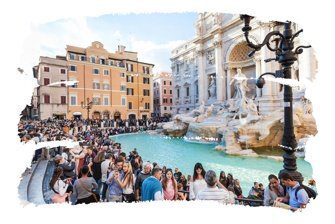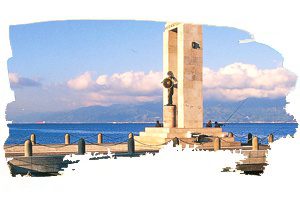Paestum: the Greek city of Campania
Approximately 100 km away from Naples, we find an ancient Greek city that, to this day, impresses the passionate about history: Paestum. Also called Pesto, the city presents itself in a glorious way amidst ruins, history and a lot of beauty. Today we will get to know Paestum. Here at Your Travel to Italy with Ana Patricia you make the trip of your dreams !!! ALSO: see our “Accommodation in Italy – Tips for your holidays!”.
Watch this amazing video with images from Paestum, Campania!
(Source: THEWORLDOFTRAVEL)
Our Introduction
The Greek influence on Italian history is undeniable and sometimes visible even today in several Italian locations, especially in the south of the country. One of the most beautiful examples of Greek heritage on Italian territory is the splendid city of Paestum in Campania.
Paestum is a maritime city and has 15 km of beaches bathed by the Cilento Sea. It’s a popular summer destination, but the heart of the city is its archaeological park. Here, the architecture, art, and culture of ancient Greece still live in a unique, beautiful and attractive way. It all started around the 1700s, when the first travelers visited Paestum without knowing what to think of the Doric temples, but the magnitude of their beauty and grandeur served as a basis to awaken the fascination that the site of Magna Graecia has exerted since then. Find out here if it is worth hiring a Specialized Consultancy in Travel to Italy.
The archaeological area of Paestum
The archaeological area of Paestum was recognized in 1998 by UNESCO as a World Heritage Site and is surrounded by well-preserved walls and towers; there you will also find a rich museum that houses objects of predominantly Greek manufacture, all found in various necropolises in the area. Paestum is a very important archaeological site for the world! In Capaccio, in the province of Salerno, the “Piana di Paestum“, as the ancestors called it, extends from the foot of the mountain to the sea.
A little more about the archaeological area…
The region was already inhabited in prehistoric times and Strabo – the most famous Roman geographer – tells that Jason, the hero of the Golden Fleece, had the power to heal using magic. With his followers, the Argonauts, he stopped at the mouth of the Sele river, and dedicated a shrine to Hera (protector of the Argonauts), and in that moment, everything, in fact, would have begun! The fertility of the plain and the abundance of the waters of Sele, was one of the main ‘meeting points’ between East and West – already in the second millennium BC.
The Greeks, in love with the geographical position of the area, founded Paestum, around 600 BC, a city they called Poseidonia, in a clear homage to the god of the seas. The development of the construction of the city took place in the middle of the sixth century BC, and the construction of the temples began decades after the foundation of the city. Enogastronomic itinerary in Campania?
The Greek Temples of Paestum
Paestum has three Greek temples that were built between the 6th and 5th centuries BC, along with those in Athens and Agrigento, and – to this day – these Templar buildings are the best preserved of the classical period. The temples are located in the heart of the city, which extends over 120 hectares, and is surrounded by a wall that, although not completely preserved, is still one of the best preserved defensive circuits of that period.
The Temple of Hera
The Temple of Hera, also called the Basilica, is in the Southern Sanctuary of Paestum, near the Temple of Neptune. The Temple of Hera is very well preserved and is uniquely beautiful, worthy of a goddess. According to several studies, this seems to be the only Greek temple from the archaic era, and has all the columns of its structure intact: there are 50 columns along the temple, 9 columns on the façade and 18 columns in the background, on both sides. The construction of this Temple would have started in 550 BC and, of course, it is a Doric temple dedicated to Hera, the goddess of Fertility.
The Temple of Athena
Across the city, near the Northern Sanctuary, we find the Temple of Athena, which is also known as the Temple of Ceres. The Temple of Athena was built on the remains of an ancient shrine that was destroyed by fire. There, an artificial relief was created and the Temple of Athena was erected, which was higher than the entire ancient city of Poseidon.
The Temple of Neptune
Last but not least we have the Temple of Neptune, also called the Temple of Poseidon. This is the largest Temple in the Paestum Archaeological Park and, in fact, it was wrongly attributed to Neptune, as – probably – it should also have been dedicated to Hera; some say that the Temple could also be dedicated to either Zeus or Apollo. The Temple of Neptune is close to the Temple of Hera, in the Southern Sanctuary of ancient Poseidonia and its inner area is the best preserved among the three temples present on the site, making it the best preserved of the entire Greek era. The interior of the Temple is divided into three naves and it was erected a century after that of Hera, around 460 BC.
How to visit the archaeological site?
Start at the temple of Hera, head to the temple of Poseidon, and then visit the temple of Athena. Along the Via Sacra, you can also visit the Roman Forum and the Amphitheater. The National Archeology Museum is also very interesting and, among the exhibits, there are paintings, a statue of Zeus, and the famous ‘Tomb of the Diver’.
Hours and Prices
The museum and archeological areas are open from Tuesday to Sunday, from 8:30 am to 7:30 pm. Values valid for the museum and archaeological area: from December to February: 6 euros; from March to November: 12 euros. For more information and ticket purchase, you can CLICK HERE!
- Civitatis: Excursion in Paestum
- GetYouGuide: Paestum: visit to temples and museums with an archaeologist guide
Note:
- Due to the COVID-19 pandemic, opening hours may change without prior notice; inquire about opening BEFORE heading to the site. (Updated January 26, 2022).
A little more about the Temples of Paestum…
The perimeter has a trapezoidal plan, is – impressive – 4,750 meters long and twenty-eight towers strategically positioned to serve as protection for the city. It had four access doors: Porta Giustizia, Porta Marina, Porta Sirena and Porta Aurea, however, the latter was destroyed with the construction of the road to Calabria.
Among the temples, there was the “market”, which was actually the central square where the assemblies were held and the empty tomb of the mythical founder of Paestum was venerated. Even today you can see the remains of some houses, public baths and old shops; for the most part, they date back to the imperial era (1-5th century AD), although Greek influence is clearly possible.
It’s impossible not to mention…
It is impossible not to mention the magnificence of this place, founded by the Achaean settlers fleeing Sybaris; this, of course, soon aroused the ambition of conquest in the Lucani, the Italic population of the interior, who occupied it around 400 BC, changing the city’s name to Paistom.
Although the Lucanians did not reach the cultural level of the Greeks, they continued their civil and military activities, but they made significant changes in the daily life of the city: they changed the spoken language, from Greek to Osco, and also changed the culture and funeral rites. .
In the meantime, another power was expanding: Rome. In 273 BC, Rome arrived there and founded a Latin colony: Paestum. This was a period of enormous change in the city.
But life is not a bed of roses…
Paestum was abandoned and ‘off the map’ for centuries, but its temples bravely resisted! Its rediscovery was made by writers and poets of the 1500s and 1600s who, with their quotations, aroused the interest and curiosity of scholars and archaeologists, but its “real” rediscovery was in the first half of the 18th century.
At this time, Paestum has become a cult, refined and interesting tourist destination. During this period we saw European intellectuals and aristocrats fall in love with Paestum in its ruins on the Grand Tour. The place also attracted artists such as Piranesi and Goethe.
The excavations of the city
Excavations of the city began in the spring of 1907 and soon brought to great light the monuments visible today. With the arrival of Mario Napoli in charge of the excavations, the area experienced a moment of glory and success: it was during this period that the diver’s tomb and the rich Lucanian tombs were discovered.
On November 27, 1952, the National Museum was inaugurated, which presents us in a chronological and impeccable way, the four crucial periods of Paestum and its territory, going from prehistory, passing through the Greek, Lucanian and, of course, civilization , Roman.
How to get to Paestum?
1) How to get to Paestum? BY AIRPLANE
By plane: Major Italian and European cities are connected to Naples with direct flights to Capodichino Airport, in the Campania region. Naples Airport is 97 km from Paestum and you can use transport: car or train.
Also read our Special Posts about Airports in Italy:
- HOW TO GET FROM MALPENSA AIRPORT TO THE CENTER OF MILAN?
- HOW TO GO FROM VENICE AIRPORT TO THE CENTER OF VENICE?
- HOW TO GO FROM CIAMPINO AIRPORT TO THE CENTER OF ROME?
2) How to get to Paestum? BY TRAIN
By train: Salerno and Battipaglia are the main stops on the Naples–Reggio Calabria line; this is where trains depart and arrive for the stations of Capaccio and Paestum – they are 40 km from Salerno. To reach the archaeological area, get off at Paestum station and follow the road that crosses Porta Sirena; a 15-minute walk.
Did you know?
Trenitalia is the main Italian company dedicated to the management of railway transport? Also find out ” What is the difference between trains in Italy?”. Would you like to save? So buy your ticket online in advance and save a lot, read the Post “How to buy a train ticket in Italy?“.
3) How to get to Paestum? BY CAR
By car: from the A3 Salerno-Reggio Calabria highway, take the north exit at Battipaglia and take state highway 18; exit south at Eboli and use the SS 18. From here, exit at Capaccio Scalo and take Laura di Paestum (23 km from the Battipaglia exit and 20 km from the Eboli exit).
Traveling by car in Italy
How about if I give you a rental car option? Are you ready for it? If you are renting a car be sure to read our posts in the section Driving in Italy on the blog Your Travel to Italy. In addition to car itinerary tips, we have everything about signage, tolls, roads and many more tips.
Don’t know where to rent the car?
We have a partner that can help you: Rent Cars! Have you ever thought about renting a car in Italy, without leaving your home? Click on the banner below to learn more! Search, compare and choose!
Watch this video and live a unique experience in Tuscany!
Subscribe to our channel and receive more videos with information and tips about Italy. Don’t forget to leave that Like;)
Conclusion
Paestum: the Greek city of Campania – As we have seen, our dear Greece played a fundamental role in Italian history. The Greeks brought us art, culture, and magnificent buildings, leaving us a valuable heritage! If you can, include Paestum in your itinerary: I’m sure you won’t regret it!
Are you insecure?
And if you feel insecure, have no time, and need help to organize your trip, don’t hesitate to contact me! I will love to help you make your dream trip to Italy come true. And how can I do that? Keep reading this post until the end and you will understand how we make your life and your trip much easier.
Did my post help you? If so, be sure to post your comment below, but if you still have questions just send me a message I will answer you as soon as possible!
An Extra Help for your Trip The best content from Your Travel to Italy! Learn more about our tours in Italy right now! Best regards from Italy






 Save money!
Save money!